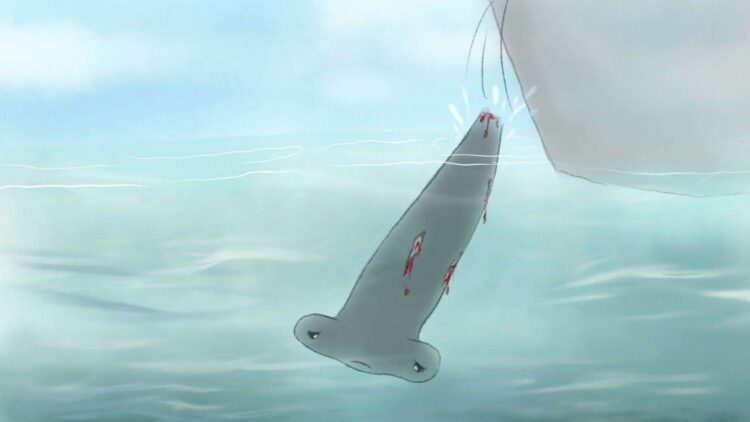Seafood’s Dark Secret: Killing Turtles, Whales & Other Marine Animals


The air conditioning of the small office was a welcome respite from the suffocating humidity the July day I visited the Turtle Hospital in the Florida Keys. Arriving a few minutes after the hourly tour started, I took a seat at the back of the room as Meghan, our tour guide, explained that 80 percent of the turtles who come through the hospital are afflicted with fibropapilloma. The virus, she explained, was due to human-caused toxins in the water resulting in benign tumors on the animals’ skin.
I continued listening as Meghan enumerated the many impacts people have on the turtle population in the Keys. The turtles suffering from the virus seemed to be the lucky ones; most could be treated then released. While humans’ impact on these majestic creatures was becoming ever clearer throughout the course of the tour, it was the loggerhead who swam alone in a large pool whose story still haunts me.
Massive, slow, and graceful, Tondelaya seemed to soar gracefully through the water as she dipped her flippers in, surfacing periodically to poke her beak out of the water. Her face was alien, albeit beautiful, birdlike with a shell the size of a manhole cover. Loggerhead turtles can grow to be as much as 500 pounds and live 50 years or more. This one arrived at the hospital with fishing net wrapped very tightly wrapped around one of her flippers. As Meghan shared, Tondelaya was fortunate in a way because many turtles lose flippers to such entanglements and in her case, the hospital was able to save her afflicted limb. She was healing from her wounds and the hospital would release her back into the ocean once recovered, Meghan continued. Those slow graceful laps she swam during my visit helped heal the wound by pumping blood into the flipper.
I left the hospital inspired by and grateful for the people who work daily taking care of these magnificent beings, but sadly we can’t just rescue and rehabilitate our way out of this problem. And it turns out the problems with fishing gear don’t end with sea turtles: there are major impacts on marine mammals as well.
In the spring of 2012 my husband and I took a long weekend to visit Maui. The relaxing vacation was punctuated by a couple of water expeditions. First, we took a snorkeling trip where, while battling through a bout of seasickness, I encountered turtles and fishes of all shapes, sizes and species up close. We followed with a whale watching adventure, which unbeknownst to us, was accentuated by the fact that we fortuitously visited during peak season for whale sightings. Scientists estimate that a third to a half of North Pacific Humpback Whales pass through Hawaii every year and Hawaii is where many of the whales in the North Pacific go to give birth to their calves. It seemed like when it came to whale sightings, we’d hit the proverbial jackpot. Whales were everywhere. We oohed and ahhed along with our boatmates as whales swam alongside our boat and a humpback breeched in the distance.

With people’s fascination of these massive, majestic creatures, whale watching not surprisingly has become a booming industry. An estimated 13 million of us whale watch every year, generating $2.1 billion for tour operators. As captivated as we are with these regal animals, most of us would be surprised and disheartened to learn that what we eat—in particular fish—has a devastating impact on them.
People may know that whales are deliberately killed by some whaling nations, but commercial fishing has now become the major threat to whales. In fact, according to the organization Whale and Dolphin Conservation, “the biggest killer of whales and dolphins across the world is accidental capture in fishing gear.” Scientists estimate the loss of life to be a staggering 380,000 a year.
The nets cause some animals who need to surface in order to breathe to suffocate, unable to free themselves from the gear, while others may be unable to hunt for food and starve to death. Entanglements can also lead to injuries to marine mammals that may drag the gear for an extended period of time ranging from tissue to bone damage. Tightly wound ropes can cause whales to lose limbs, tails, or other body parts.
Regulatory agencies have made some strides to protect marine mammals and reduce the threat of entanglement. Regulations mandated by The National Marine Fisheries Service require fishing nets and lines running between lobster traps to be weighted, causing them to rest on the ocean floor to reduce the risk of entanglement. In 2016, the California Department of Fish and Wildlife issued an advisory to crab-vessel permit holders requesting them to remove gear in areas where whale and risk-prone fishing gear overlap. And in 2016, California Governor Jerry Brown signed a bill into law that would incentivize fisherman to gather abandoned gear they find to reduce the number of whales entangled.
Michael Moore, a biologist with Woods Hole Oceanographic Institute in Massachusetts, has performed necropsies on entangled whales, documenting extensive injuries caused by fishing gear. His heart-wrenching work led him to write an article, “How we all kill whales,” and in an interview with The Humane Society of the United States pointed to us—consumers—as the ones who can help bring about change. Moore stated, “My own belief, as a veterinarian, is that we are responsible for the wellbeing of those animals.” And that, “We are causing obvious pain.”
To be part of the solution, for the sea turtle I encountered in the Keys, the whales swimming around the Hawaiian islands, and all their brethren around the world, we need look no further than our plates. If we’re consuming seafood perhaps the easiest — and tastiest — way to help is by practicing the Three Rs. We can “reduce” or “replace” our consumption of animal products with plant-based foods and “refine” our diets by choosing products from sources using higher animal welfare standards. Fortunately, from the fridge to the freezer section, if you’re in the mood for seafood, there’s an abundance of delicious plant-based items on the market from fish-free filets to crab-less cakes to vegetarian sushi.
The struggle to end the tragic turtle and whale killings (not to mention shark finning) in our oceans will continue. However, as more and more of us join together in protest, I’m confident we’ll turn the oceans into a more peaceful place for our fellow creatures. Because it turns out, after all, that we can all free the animals from fishing nets. And it starts with our forks and knives.











Leave a Comment